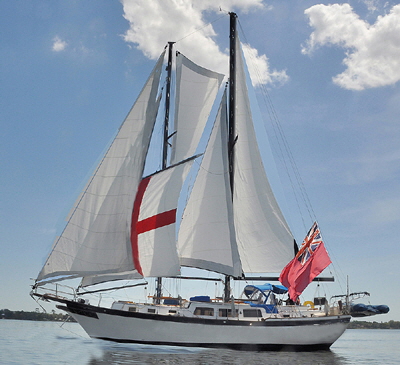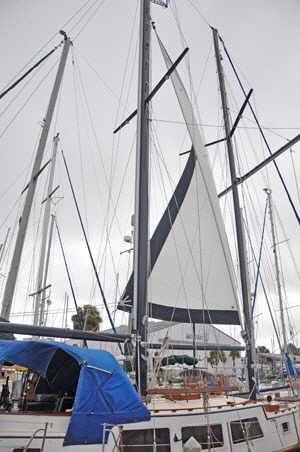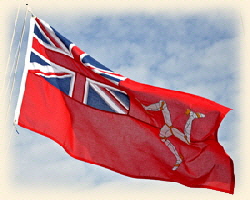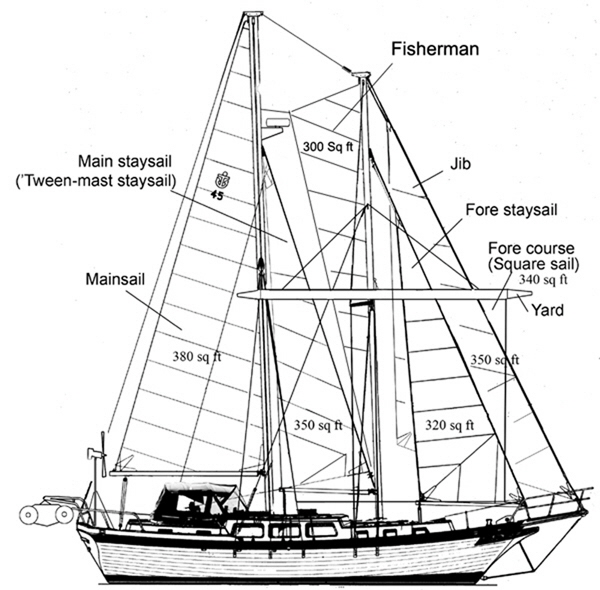Britannia is now a brigantine schooner, that is, a two masted vessel having at least one squaresail on the foremast. The sail plan is a staysail schooner, but with a taller than normal foremast to accommodate the squaresail.
All sails are roller furled, including the squaresail, that rolls up inside the yard. Roller furling sails considerably reduce the workload and time in pulling them up and down, and allows for infinite reefing - including the squaresail. Roller furling also removes the need for sail covers. The downside is that a roller furled sail has to be cut flat, so it can roll up round its forestay without bunching. This sail does not “pull” as well as one that has bunt (curvature) built in. But most cruising sailors are prepared to accept the slight loss of drive for the other advantages. This loss does not of course apply to a squaresail when the wind is blowing directly into the back of the canvas, and basically pushing the boat along.
A staysail schooner rig is well known for its beam reaching power, i.e. when the wind is from the side of the boat. Also, when all sails are sheeted hard a schooner makes quite well to windward and also having both staysails on booms means the jib is the only sail to tack, all others being self-tacking. Altogether, it is a very workable rig for a blue water cruising boat.
Bermudian sails do not work well with the wind aft, because the sail is triangular and the wind is not pressing evenly into the sail, causing it to easily loose its wind and flop all over the place. To avoid this a whisker pole can be rigged, (that is actually a form of yard), to keep the sail flat. Even so, constant attention to steering is needed on a run, especially in big following seas. A squaresail set on the foremast has none of these problems and steering is very easy by both helmsman or autopilot - hence the age old combination of fore and aft and squaresails on a Brigantine.
Britannia’s head sails are cutter rigged, i.e. jib and boomed fore staysail. The additional foremast height gives a 4’ foot wide slot between the jib and staysail allowing the jib to easily pass through when tacking.
The next sail aft is the main staysail, also known as the ‘tweenmast staysail, because it is between the two masts. This is set on a hefty stay that also acts as the main brace for the mainmast. Because the sail is roller furled I had the foot made 6’ feet longer than its 9’ foot long boom. When on a reach or broad reach the sail can be unrolled completely and sheeted further aft to become a much more powerful sail, similar to a mizzen staysail on a ketch. When on the wind the sail is partially rolled and reattached to its boom, where it becomes self tacking.
The large mainsail rolls in and out of a slotted tube attached all the way up the back of the mast. There are a number of manufacturers of this after-market method and I choose the French Facnor system. This is extremely well engineered, reasonably priced compared to others, and with good boating magazine reports and personal recommendations. The mainsail is the largest of the four fore and aft sails yet it is easily controlled from the cockpit and can be reefed or completely stowed in a matter of minutes.
 There is a possibility on a staysail schooner for yet another sail to fill the gap between the masts. This can be a Fisherman, like an upside down jib run up the back of the foremast (see sail plan above). Or it can be a Gollywobbler, a quadrilateral sail that flys above the main staysail and sheets to the mainmast in two places. I will eventually install a Fisherman of light sailcloth that will work well when the wind is light because it is high up the mast. This sail will be roller furled like all the others and have the advantage of also being self tacking
There is a possibility on a staysail schooner for yet another sail to fill the gap between the masts. This can be a Fisherman, like an upside down jib run up the back of the foremast (see sail plan above). Or it can be a Gollywobbler, a quadrilateral sail that flys above the main staysail and sheets to the mainmast in two places. I will eventually install a Fisherman of light sailcloth that will work well when the wind is light because it is high up the mast. This sail will be roller furled like all the others and have the advantage of also being self tacking
Another sail what is possible by having a yard mounted on the foremast is called a Raffee. (not shown on the drawing for clarity), This is a triangular sail of light cloth, set flying from the top of the foremast and sheeted through blocks on the yard, down to the cockpit. It is really an additional down-wind sail, but when the yard is braced the Raffee automatically adjusts as well. On Britannia this would be about 150 sq ft., and be used in conjunction with the square-sail or separately.
Britannia is a unique sailing vessel that looks complicated to the untrained eye. Yet she is easy to handle in any condition,s because of the options available with the various sails and the ease of handling them.
